Zinc Oxide Nanoparticles and Their Application in Adsorption of Toxic Dye from Aqueous Solution
Abstract
1. Introduction
2. Materials and Methods
2.1. Materials
2.2. Synthesis of ZnO Nanoparticles
2.3. Preparation of Dye Solution
2.4. ZnO-NP Characterisation
2.5. Adsorption Experiments
2.5.1. Batch Adsorption Experiments
2.5.2. Analytical Techniques
2.6. Study of the Adsorption Isotherm
2.6.1. Experiment with Isotherms
2.6.2. Freundlich Model
2.6.3. The Langmuir Model
2.6.4. Henderson and Halsey Models
2.6.5. The Harkins-Jura Model
2.7. Error Function Test
2.7.1. Hybrid Fractional Error (HYBRID)
2.7.2. Error Percentage Average (APE)
2.7.3. Nonlinear Chi-Square Test (Nonlinear Chi-Square Test)
2.7.4. Sum of Absolute Errors (EABS)
2.8. Adsorption Kinetics
2.8.1. Pseudo-First-Order Kinetics
2.8.2. Pseudo-Second-Order Kinetics
2.8.3. The Intraparticle Diffusion Model
2.9. Thermodynamics of Adsorption
3. Results and Discussion
3.1. ZnO-NP Characterisation
3.1.1. Infrared Spectroscopy (FTIR)
3.1.2. BET Surface Analysis
3.1.3. SEM Examination
3.1.4. UV–Visible Spectra
3.2. Adsorption Experiments
3.2.1. Influence of pH
3.2.2. Influence of ZnO-NP Dose
3.2.3. Influence of Contact Time
3.2.4. Influence of the Initial Dye Concentration
3.2.5. Influence of Temperature
3.3. Isothermal Analysis
3.3.1. Freundlich Isotherm
3.3.2. Langmuir Isotherm
3.3.3. Harkins-Jura Isotherm
3.3.4. Isotherm Models of Halsey and Henderson
3.3.5. Tempkin Isotherm
3.4. Examining Error Functions to Find the Most Appropriate Isotherm Model
3.5. Adsorption Kinetics
3.5.1. Model of Pseudo-First-Order Kinetics
3.5.2. Model of Pseudo-Second-Order Kinetics
3.5.3. The Intraparticle Diffusion Equation
3.6. Adsorption Thermodynamics
3.7. Application to Real-Life Wastewater
3.8. Comparative Studies of ZnO-NP Sorption Capacity
4. Conclusions
Funding
Institutional Review Board Statement
Informed Consent Statement
Data Availability Statement
Acknowledgments
Conflicts of Interest
References
- Yogendra, K.; Mahadevan, K.; Naik, S.; Madhusudhana, N. Photocatalytic activity of synthetic ZnO composite against Coralene red F3BS dye in presence of solar light. Int. J. Environ. Sci. 2011, 1, 839–846. [Google Scholar]
- Abualnaja, K.M.; Alprol, A.E.; Ashour, M.; Mansour, A.T. Influencing Multi-Walled Carbon Nanotubes for the Removal of Ismate Violet 2R Dye from Wastewater: Isotherm, Kinetics, and Thermodynamic Studies. Appl. Sci. 2021, 11, 4786. [Google Scholar] [CrossRef]
- Abualnaja, K.M.; Alprol, A.E.; Abu-Saied, M.A.; Ashour, M.; Mansour, A.T. Removing of Anionic Dye from Aqueous Solutions by Adsorption Using of Multiwalled Carbon Nanotubes and Poly (Acrylonitrile-styrene) Impregnated with Activated Carbon. Sustainability 2021, 13, 7077. [Google Scholar] [CrossRef]
- Abualnaja, K.M.; Alprol, A.E.; Abu-Saied, M.A.; Mansour, A.T.; Ashour, M. Studying the Adsorptive Behavior of Poly(Acrylonitrile-co-Styrene) and Carbon Nanotubes (Nanocomposites) Impregnated with Adsorbent Materials towards Methyl Orange Dye. Nanomaterials 2021, 11, 1144. [Google Scholar] [CrossRef] [PubMed]
- Aksu, Z. Application of biosorption for the removal of organic pollutants: A review. Process Biochem. 2005, 40, 997–1026. [Google Scholar] [CrossRef]
- Guivarch, E.; Trevin, S.; Lahitte, C.; Oturan, M.A. Degradation of azo dyes in water by electro-Fenton process. Environ. Chem. Lett. 2003, 1, 38–44. [Google Scholar] [CrossRef]
- Alprol, A.E.; Ashour, M.; Mansour, A.T.; Alzahrani, O.M.; Mahmoud, S.F.; Gharib, S.M. Assessment of Water Quality and Phytoplankton Structure of Eight Alexandria Beaches, Southeastern Mediterranean Sea, Egypt. J. Mar. Sci. Eng. 2021, 9, 1328. [Google Scholar] [CrossRef]
- Alprol, A.E.; Heneash, A.M.M.; Soliman, A.M.; Ashour, M.; Alsanie, W.F.; Gaber, A.; Mansour, A.T. Assessment of Water Quality, Eutrophication, and Zooplankton Community in Lake Burullus, Egypt. Diversity 2021, 13, 268. [Google Scholar] [CrossRef]
- Bayramoğlu, G.; Arıca, M.Y. Biosorption of benzidine based textile dyes “Direct Blue 1 and Direct Red 128” using native and heat-treated biomass of Trametes versicolor. J. Hazard. Mater. 2007, 143, 135–143. [Google Scholar] [CrossRef]
- Harper, T.R.; Kingham, N.W. Removal of arsenic from wastewater using chemical precipitation methods. Water Environ. Res. 1992, 64, 200–203. [Google Scholar] [CrossRef]
- Song, Z.; Williams, C.; Edyvean, R. Treatment of tannery wastewater by chemical coagulation. Desalination 2004, 164, 249–259. [Google Scholar] [CrossRef]
- Semerjian, L.; Ayoub, G. High-pH–magnesium coagulation–flocculation in wastewater treatment. Adv. Environ. Res. 2003, 7, 389–403. [Google Scholar] [CrossRef]
- Schwermer, C.U.; Krzeminski, P.; Wennberg, A.C.; Vogelsang, C.; Uhl, W. Removal of antibiotic resistant E. coli in two Norwegian wastewater treatment plants and by nano-and ultra-filtration processes. Water Sci. Technol. 2018, 77, 1115–1126. [Google Scholar] [CrossRef]
- Deng, Y.; Zhao, R. Advanced oxidation processes (AOPs) in wastewater treatment. Curr. Pollut. Rep. 2015, 1, 167–176. [Google Scholar] [CrossRef]
- Golder, A.K.; Chanda, A.K.; Samanta, A.N.; Ray, S. Removal of hexavalent chromium by electrochemical reduction–precipitation: Investigation of process performance and reaction stoichiometry. Sep. Purif. Technol. 2011, 76, 345–350. [Google Scholar] [CrossRef]
- Guida, S.; Van Peteghem, L.; Luqmani, B.; Sakarika, M.; McLeod, A.; McAdam, E.J.; Jefferson, B.; Rabaey, K.; Soares, A. Ammonia recovery from brines originating from a municipal wastewater ion exchange process and valorization of recovered nitrogen into microbial protein. Chem. Eng. J. 2022, 427, 130896. [Google Scholar] [CrossRef]
- Abo-Taleb, H.A.; Ashour, M.; Elokaby, M.A.; Mabrouk, M.M.; El-feky, M.M.M.; Abdelzaher, O.F.; Gaber, A.; Alsanie, W.F.; Mansour, A.T. Effect of a New Feed Daphniamagna (Straus, 1820), as a Fish Meal Substitute on Growth, Feed Utilization, Histological Status, and Economic Revenue of Grey Mullet, Mugil cephalus (Linnaeus 1758). Sustainability 2021, 13, 7093. [Google Scholar] [CrossRef]
- Mansour, A.T.; Ashour, M.; Alprol, A.E.; Alsaqufi, A.S. Aquatic Plants and Aquatic Animals in the Context of Sustainability: Cultivation Techniques, Integration, and Blue Revolution. Sustainability 2022, 14, 3257. [Google Scholar] [CrossRef]
- Zaki, M.A.; Ashour, M.; Heneash, A.M.M.; Mabrouk, M.M.; Alprol, A.E.; Khairy, H.M.; Nour, A.M.; Mansour, A.T.; Hassanien, H.A.; Gaber, A.; et al. Potential Applications of Native Cyanobacterium Isolate (Arthrospira platensis NIOF17/003) for Biodiesel Production and Utilization of Its Byproduct in Marine Rotifer (Brachionus plicatilis) Production. Sustainability 2021, 13, 1769. [Google Scholar] [CrossRef]
- Mansour, A.T.; Alprol, A.E.; Ashour, M.; Ramadan, K.M.; Alhajji, A.H.; Abualnaja, K.M. Do Red Seaweed Nanoparticles Enhance Bioremediation Capacity of Toxic Dyes from Aqueous Solution? Gels 2022, 8, 310. [Google Scholar] [CrossRef]
- Ashour, M.; Alprol, A.E.; Heneash, A.M.M.; Saleh, H.; Abualnaja, K.M.; Alhashmialameer, D.; Mansour, A.T. Ammonia Bioremediation from Aquaculture Wastewater Effluents Using Arthrospira platensis NIOF17/003: Impact of Biodiesel Residue and Potential of Ammonia-Loaded Biomass as Rotifer Feed. Materials 2021, 14, 5460. [Google Scholar] [CrossRef]
- Mansour, A.T.; Alprol, A.E.; Abualnaja, K.M.; El-Beltagi, H.S.; Ramadan, K.M.A.; Ashour, M. Dried Brown Seaweed’s Phytoremediation Potential for Methylene Blue Dye Removal from Aquatic Environments. Polymers 2022, 14, 1375. [Google Scholar] [CrossRef]
- Mansour, A.T.; Alprol, A.E.; Abualnaja, K.M.; El-Beltagi, H.S.; Ramadan, K.M.A.; Ashour, M. The Using of Nanoparticles of Microalgae in Remediation of Toxic Dye from Industrial Wastewater: Kinetic and Isotherm Studies. Materials 2022, 15, 3922. [Google Scholar] [CrossRef]
- Ghiloufi, I.; El Ghoul, J.; Modwi, A.; El Mir, L. Ga-doped ZnO for adsorption of heavy metals from aqueous solution. Mater. Sci. Semicond. Process. 2016, 42, 102–106. [Google Scholar] [CrossRef]
- Agrawal, A.; Sahu, K. Kinetic and isotherm studies of cadmium adsorption on manganese nodule residue. J. Hazard. Mater. 2006, 137, 915–924. [Google Scholar] [CrossRef]
- Zeng, H.; Cai, W.; Liu, P.; Xu, X.; Zhou, H.; Klingshirn, C.; Kalt, H. ZnO-based hollow nanoparticles by selective etching: Elimination and reconstruction of metal− semiconductor interface, improvement of blue emission and photocatalysis. ACS Nano 2008, 2, 1661–1670. [Google Scholar] [CrossRef]
- Jing, Z.; Zhan, J. Fabrication and gas-sensing properties of porous ZnO nanoplates. Adv. Mater. 2008, 20, 4547–4551. [Google Scholar] [CrossRef]
- Chou, T.P.; Zhang, Q.; Fryxell, G.E.; Cao, G. Hierarchically Structured ZnO Film for Dye-Sensitized Solar Cells with Enhanced Energy Conversion Efficiency. Adv. Mater. 2007, 19, 2588–2592. [Google Scholar] [CrossRef]
- Azizi, S.; Mohamad, R.; Bahadoran, A.; Bayat, S.; Rahim, R.A.; Ariff, A.; Saad, W.Z. Effect of annealing temperature on antimicrobial and structural properties of bio-synthesized zinc oxide nanoparticles using flower extract of Anchusa italica. J. Photochem. Photobiol. B Biol. 2016, 161, 441–449. [Google Scholar] [CrossRef]
- Azizi, S.; Ahmad, M.B.; Namvar, F.; Mohamad, R. Green biosynthesis and characterization of zinc oxide nanoparticles using brown marine macroalga Sargassum muticum aqueous extract. Mater. Lett. 2014, 116, 275–277. [Google Scholar] [CrossRef]
- Naseer, M.; Aslam, U.; Khalid, B.; Chen, B. Green route to synthesize Zinc Oxide Nanoparticles using leaf extracts of Cassia fistula and Melia azadarach and their antibacterial potential. Sci. Rep. 2020, 10, 1–10. [Google Scholar] [CrossRef] [PubMed]
- Elia, P.; Zach, R.; Hazan, S.; Kolusheva, S.; Porat, Z.e.; Zeiri, Y. Green synthesis of gold nanoparticles using plant extracts as reducing agents. Int. J. Nanomed. 2014, 9, 4007. [Google Scholar]
- Yu, J.-G.; Yu, L.-Y.; Yang, H.; Liu, Q.; Chen, X.-H.; Jiang, X.-Y.; Chen, X.-Q.; Jiao, F.-P. Graphene nanosheets as novel adsorbents in adsorption, preconcentration and removal of gases, organic compounds and metal ions. Sci. Total Environ. 2015, 502, 70–79. [Google Scholar] [CrossRef] [PubMed]
- Hassan, K.H.; Khammas, Z.A.; Rahman, A.M. Zinc oxide hydrogen sulfide removal catalyst/preparation, activity test and kinetic study. Al-Khwarizmi Eng. J. 2008, 4, 74–84. [Google Scholar]
- Wang, X.; Cai, W.; Lin, Y.; Wang, G.; Liang, C. Mass production of micro/nanostructured porous ZnO plates and their strong structurally enhanced and selective adsorption performance for environmental remediation. J. Mater. Chem. 2010, 20, 8582–8590. [Google Scholar] [CrossRef]
- Abd El-Mohdy, H.; Mostafa, T.B. Synthesis of Polyvinyl Alcohol/Maleic Acid Hydrogels by Electron Beam Irradiation for Dye Uptake. J. Macromol. Sci. Part A 2013, 50, 6–17. [Google Scholar] [CrossRef]
- Dada, A.; Olalekan, A.; Olatunya, A.; Dada, O. Langmuir, Freundlich, Temkin and Dubinin–Radushkevich isotherms studies of equilibrium sorption of Zn2+ unto phosphoric acid modified rice husk. IOSR J. Appl. Chem. 2012, 3, 38–45. [Google Scholar]
- Freundlich, H. Über die Adsorption in Lösungen. Habilitationsschrift durch Welche... zu Haltenden Probevorlesung“ Kapillarchemie und Physiologie” einladet Dr. Herbert Freundlich; W. Engelmann: Berlin, German, 1906. [Google Scholar]
- Langmuir, I. The constitution and fundamental properties of solids and liquids. Part I. Solids. J. Am. Chem. Soc. 1916, 38, 2221–2295. [Google Scholar]
- Halsey Jr, G. The Rate of Adsorption on a Nonuniform Surface. J. Phys. Chem. 1951, 55, 21–26. [Google Scholar] [CrossRef]
- Harkins, W.D.; Jura, G. An adsorption method for the determination of the area of a solid without the assumption of a molecular area, and the area occupied by nitrogen molecules on the surfaces of solids. J. Chem. Phys. 1943, 11, 431–432. [Google Scholar] [CrossRef]
- Pandimurugan, R.; Thambidurai, S. Novel seaweed capped ZnO nanoparticles for effective dye photodegradation and antibacterial activity. Adv. Powder Technol. 2016, 27, 1062–1072. [Google Scholar] [CrossRef]
- Abul, A.; Samad, S.; Huq, D.; Moniruzzaman, M.; Masum, M. Textile dye removal from wastewater effluents using chitosan-ZnO nanocomposite. J. Text. Sci. Eng. 2015, 5, 3–7. [Google Scholar]
- Jabs, A. Determination of Secondary Structure in Proteins by Fourier Transform Infrared Spectroscopy (FTIR). Jena Library of Biologica Macromolecules. 2005. Available online: http://www.imb-jena.de/ImgLibDoc/ftir/IMAGEpFTIR.html (accessed on 30 December 2020).
- Figueira, M.; Volesky, B.; Mathieu, H. Instrumental analysis study of iron species biosorption by Sargassum biomass. Environ. Sci. Technol. 1999, 33, 1840–1846. [Google Scholar] [CrossRef]
- Sharma, D.; Sabela, M.I.; Kanchi, S.; Bisetty, K.; Skelton, A.A.; Honarparvar, B. Green synthesis, characterization and electrochemical sensing of silymarin by ZnO nanoparticles: Experimental and DFT studies. J. Electroanal. Chem. 2018, 808, 160–172. [Google Scholar]
- Samaele, N.; Amornpitoksuk, P.; Suwanboon, S. Effect of pH on the morphology and optical properties of modified ZnO particles by SDS via a precipitation method. Powder Technol. 2010, 203, 243–247. [Google Scholar] [CrossRef]
- Sagar, P.; Shishodia, P.; Mehra, R. Influence of pH value on the quality of sol–gel derived ZnO films. Appl. Surf. Sci. 2007, 253, 5419–5424. [Google Scholar] [CrossRef]
- Belda, I.; Ruiz, J.; Esteban-Fernández, A.; Navascués, E.; Marquina, D.; Santos, A.; Moreno-Arribas, M.V. Microbial contribution to wine aroma and its intended use for wine quality improvement. Molecules 2017, 22, 189. [Google Scholar] [CrossRef] [PubMed]
- Boukoussa, B.; Hamacha, R.; Morsli, A.; Bengueddach, A. Adsorption of yellow dye on calcined or uncalcined Al-MCM-41 mesoporous materials. Arab. J. Chem. 2017, 10, S2160–S2169. [Google Scholar] [CrossRef]
- Netpradit, S.; Thiravetyan, P.; Towprayoon, S. Application of ‘waste’metal hydroxide sludge for adsorption of azo reactive dyes. Water Res. 2003, 37, 763–772. [Google Scholar] [CrossRef]
- O’mahony, T.; Guibal, E.; Tobin, J. Reactive dye biosorption by Rhizopus arrhizus biomass. Enzym. Microb. Technol. 2002, 31, 456–463. [Google Scholar] [CrossRef]
- Blaga, A.C.; Tanasă, A.M.; Cimpoesu, R.; Tataru-Farmus, R.-E.; Suteu, D. Biosorbents Based on Biopolymers from Natural Sources and Food Waste to Retain the Methylene Blue Dye from the Aqueous Medium. Polymers 2022, 14, 2728. [Google Scholar] [CrossRef]
- Karaca, S.; Gürses, A.; Açıkyıldız, M.; Ejder, M. Adsorption of cationic dye from aqueous solutions by activated carbon. Microporous Mesoporous Mater. 2008, 115, 376–382. [Google Scholar] [CrossRef]
- Ghoneim, M.M.; El-Desoky, H.S.; El-Moselhy, K.M.; Amer, A.; Abou El-Naga, E.H.; Mohamedein, L.I.; Al-Prol, A.E. Removal of cadmium from aqueous solution using marine green algae, Ulva lactuca. Egypt. J. Aquat. Res. 2014, 40, 235–242. [Google Scholar] [CrossRef]
- Malik, R.; Ramteke, D.; Wate, S. Adsorption of malachite green on groundnut shell waste based powdered activated carbon. Waste Manag. 2007, 27, 1129–1138. [Google Scholar] [CrossRef]
- Reddy, S.S. The removal of composite reactive dye from dyeing unit effluent using sewage sludge derived activated carbon. Turk. J. Eng. Environ. Sci. 2006, 30, 367–373. [Google Scholar]
- Iqbal, M.; Saeed, A. Biosorption of reactive dye by loofa sponge-immobilized fungal biomass of Phanerochaete chrysosporium. Process Biochem. 2007, 42, 1160–1164. [Google Scholar] [CrossRef]
- Zafar, S.I.; Bisma, M.; Saeed, A.; Iqbal, M. FTIR spectrophotometry, kinetics and adsorption isotherms modelling, and SEM-EDX analysis for describing mechanism of biosorption of the cationic basic dye Methylene blue by a new biosorbent (Sawdust of Silver Fir; Abies Pindrow). Fresenius Environ. Bull. 2008, 17, 2109–2121. [Google Scholar]
- Ananta, S.; Saumen, B.; Vijay, V. Adsorption isotherm, thermodynamic and kinetic study of arsenic (III) on iron oxide coated granular activated charcoal. Int. Res. J. Environ. Sci. 2015, 4, 64–77. [Google Scholar]
- David, A.; Joseph, L. The Effect of Ph and Biomass Concentration on Lead (Pb) Adsorption by Aspergillus Niger from Simulated Waste Water. Bachelor’s Thesis, University Malaysia Pahang, Pahang, Malaysia, 2008. [Google Scholar]
- Kumar, P.S.; Gayathri, R. Adsorption of Pb2+ ions from aqueous solutions onto bael tree leaf powder: Isotherms, kinetics and thermodynamics study. J. Eng. Sci. Technol. 2009, 4, 381–399. [Google Scholar]
- Bao, C.; Chen, M.; Jin, X.; Hu, D.; Huang, Q. Efficient and stable photocatalytic reduction of aqueous hexavalent chromium ions by polyaniline surface-hybridized ZnO nanosheets. J. Mol. Liq. 2019, 279, 133–145. [Google Scholar] [CrossRef]
- Daija, L.; Selberg, A.; Rikmann, E.; Zekker, I.; Tenno, T.; Tenno, T. The influence of lower temperature, influent fluctuations and long retention time on the performance of an upflow mode laboratory-scale septic tank. Desalination Water Treat. 2016, 57, 18679–18687. [Google Scholar] [CrossRef]
- Putra, W.P.; Kamari, A.; Yusoff, S.N.M.; Ishak, C.F.; Mohamed, A.; Hashim, N.; Isa, I.M. Biosorption of Cu (II), Pb (II) and Zn (II) ions from aqueous solutions using selected waste materials: Adsorption and characterisation studies. J. Encapsulation Adsorpt. Sci. 2014, 4, 43532. [Google Scholar]
- Malakootian, M.; Toolabi, A.; Moussavi, S.G.; Ahmadian, M. Equilibrium and kinetic modeling of heavy metals biosorption from three different Real industrial wastewaters onto Ulothrix Zonata algae. Aust. J. Basic Appl. Sci. 2011, 5, 1030–1037. [Google Scholar]
- Sivaprakasha, S.; Kumarb, P.S.; Krishnac, S. Adsorption study of various dyes on Activated Carbon Fe3O4 Magnetic Nano Composite. Int. J. Appl. Chem. 2017, 13, e266. [Google Scholar]
- Tang, C.; Huang, X.; Wang, H.; Shi, H.; Zhao, G. Mechanism investigation on the enhanced photocatalytic oxidation of nonylphenol on hydrophobic TiO2 nanotubes. J. Hazard. Mater. 2020, 382, 121017. [Google Scholar] [CrossRef] [PubMed]
- Acharya, J.; Sahu, J.; Mohanty, C.; Meikap, B. Removal of lead (II) from wastewater by activated carbon developed from Tamarind wood by zinc chloride activation. Chem. Eng. J. 2009, 149, 249–262. [Google Scholar] [CrossRef]
- Sun, D.; Zhang, Z.; Wang, M.; Wu, Y. Adsorption of reactive dyes on activated carbon developed from Enteromorpha prolifera. Am. J. Anal. Chem. 2013, 4, 33867. [Google Scholar]
- Saeed, A.; Sharif, M.; Iqbal, M. Application potential of grapefruit peel as dye sorbent: Kinetics, equilibrium and mechanism of crystal violet adsorption. J. Hazard. Mater. 2010, 179, 564–572. [Google Scholar] [CrossRef]
- Al Prol, A. Study of environmental concerns of dyes and recent textile effluents treatment technology: A review. Asian J. Fish. Aquat. Res. 2019, 3, 1–18. [Google Scholar] [CrossRef]
- Halsey, G. Physical adsorption on non-uniform surfaces. J. Chem. Phys. 1948, 16, 931–937. [Google Scholar] [CrossRef]
- Hossain, M.; Ngo, H.; Guo, W.; Nguyen, T. Palm oil fruit shells as biosorbent for copper removal from water and wastewater: Experiments and sorption models. Bioresour. Technol. 2012, 113, 97–101. [Google Scholar] [CrossRef]
- Kavitha, D.; Namasivayam, C. Experimental and kinetic studies on methylene blue adsorption by coir pith carbon. Bioresour. Technol. 2007, 98, 14–21. [Google Scholar] [CrossRef] [PubMed]
- Kooh, M.R.R.; Dahri, M.K.; Lim, L.B. The removal of rhodamine B dye from aqueous solution using Casuarina equisetifolia needles as adsorbent. Cogent Environ. Sci. 2016, 2, 1140553. [Google Scholar] [CrossRef]
- E Al Prol, A.; EA El-Metwally, M.; Amer, A. Sargassum latifolium as eco-friendly materials for treatment of toxic nickel (II) and lead (II) ions from aqueous solution. Egypt. J. Aquat. Biol. Fish. 2019, 23, 285–299. [Google Scholar] [CrossRef][Green Version]
- Babarinde, N.A.; Oyesiku, O.; Dairo, O.F. Isotherm and thermodynamic studies of the biosorption of copper (II) ions by Erythrodontium barteri. Int. J. Phys. Sci. 2007, 2, 300–304. [Google Scholar]
- Potgieter, J.; Pearson, S.; Pardesi, C. Kinetic and thermodynamic parameters for the adsorption of methylene blue using fly ash under batch, column, and heap leaching configurations. Coal Combust. Gasif. Prod. 2018, 10, 23–33. [Google Scholar]
- Jamshidi, H.; Ghaedi, M.; Sabzehmeidani, M.M.; Bagheri, A.R. Comparative study of acid yellow 119 adsorption onto activated carbon prepared from lemon wood and ZnO nanoparticles loaded on activated carbon. Appl. Organomet. Chem. 2018, 32, e4080. [Google Scholar] [CrossRef]
- Nourmoradi, H.; Ghiasvand, A.; Noorimotlagh, Z. Removal of methylene blue and acid orange 7 from aqueous solutions by activated carbon coated with zinc oxide (ZnO) nanoparticles: Equilibrium, kinetic, and thermodynamic study. Desalination Water Treat. 2015, 55, 252–262. [Google Scholar] [CrossRef]
- Ghaedi, M.; Ghayedi, M.; Kokhdan, S.N.; Sahraei, R.; Daneshfar, A. Palladium, silver, and zinc oxide nanoparticles loaded on activated carbon as adsorbent for removal of bromophenol red from aqueous solution. J. Ind. Eng. Chemistry 2013, 19, 1209–1217. [Google Scholar] [CrossRef]
- Ghaedi, M.; Mosallanejad, N. Study of competitive adsorption of malachite green and sunset yellow dyes on cadmium hydroxide nanowires loaded on activated carbon. J. Ind. Eng. Chem. 2014, 20, 1085–1096. [Google Scholar] [CrossRef]
- Lammi, S.; Barakat, A.; Mayer-Laigle, C.; Djenane, D.; Gontard, N.; Angellier-Coussy, H. Dry fractionation of olive pomace as a sustainable process to produce fillers for biocomposites. Powder Technol. 2018, 326, 44–53. [Google Scholar] [CrossRef]
- Sarabadan, M.; Bashiri, H.; Mousavi, S.M. Removal of crystal violet dye by an efficient and low cost adsorbent: Modeling, kinetic, equilibrium and thermodynamic studies. Korean J. Chem. Eng. 2019, 36, 1575–1586. [Google Scholar] [CrossRef]
- Salih, S.J. Removal of Basic Dyes from Aqueous Solution by Chloroacetic Acid Modified Ferula Communis Based Adsorbent: Thermodynamic and Kinetic Studies; Eastern Mediterranean University (EMU)-Doğu Akdeniz Üniversitesi (DAÜ): Gazimağusa, Cyprus, 2014. [Google Scholar]
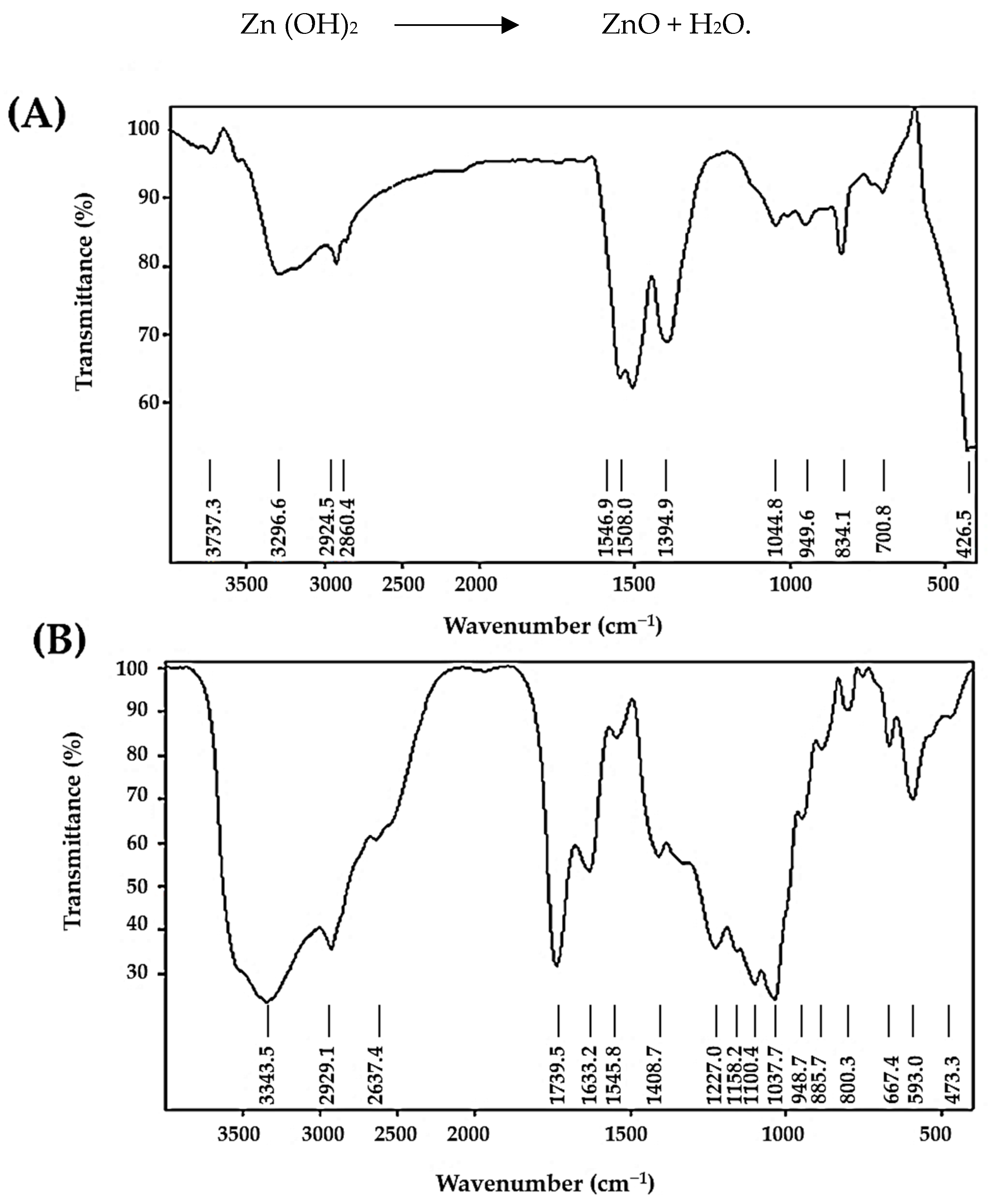

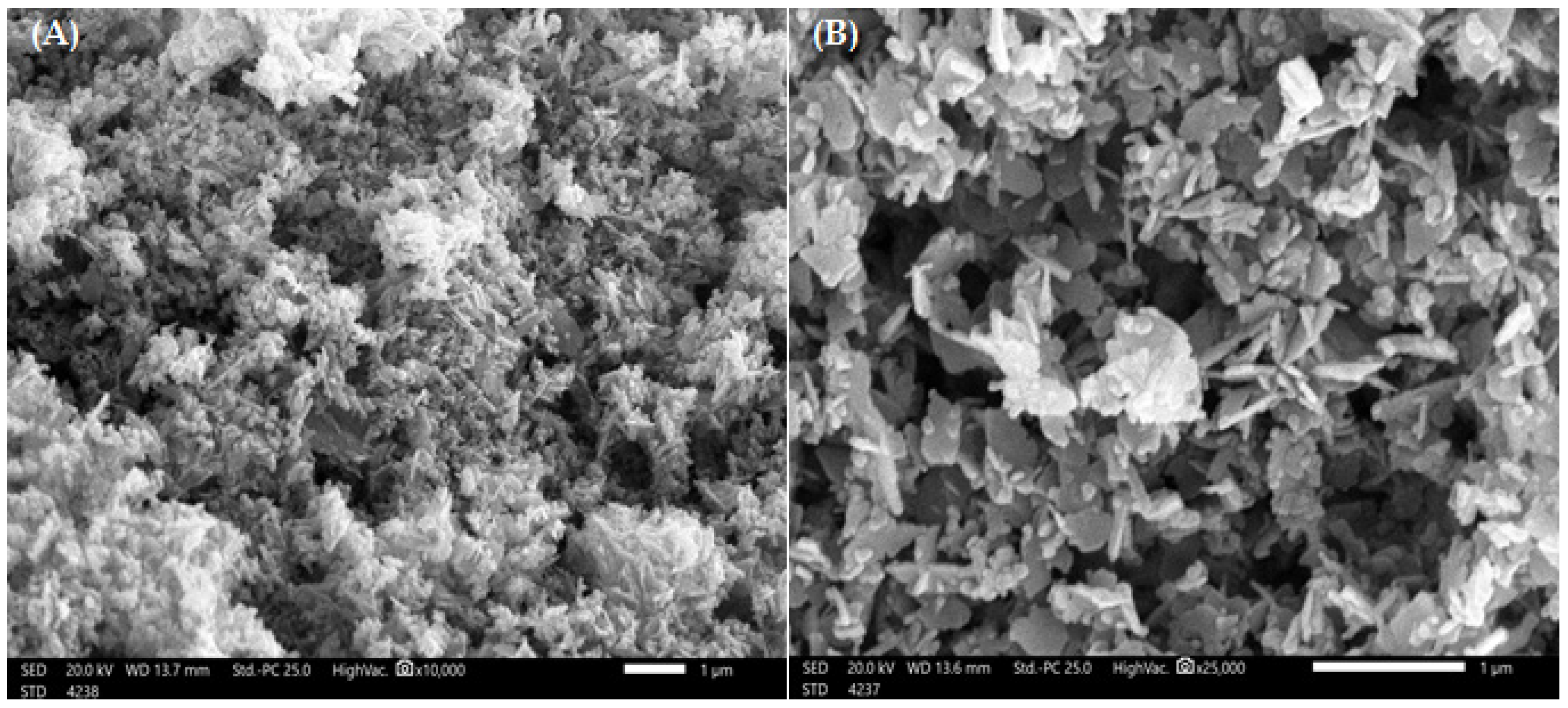
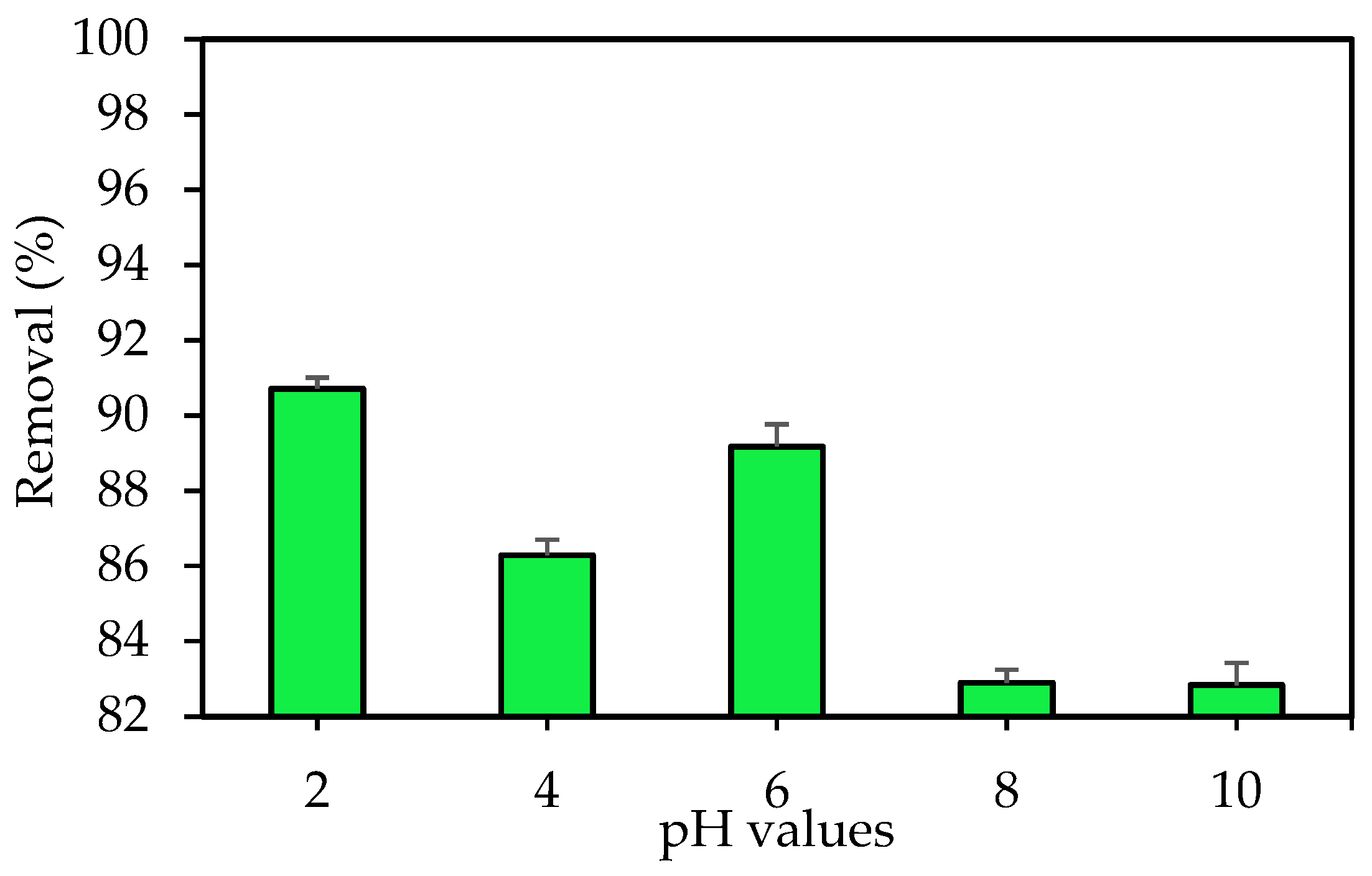
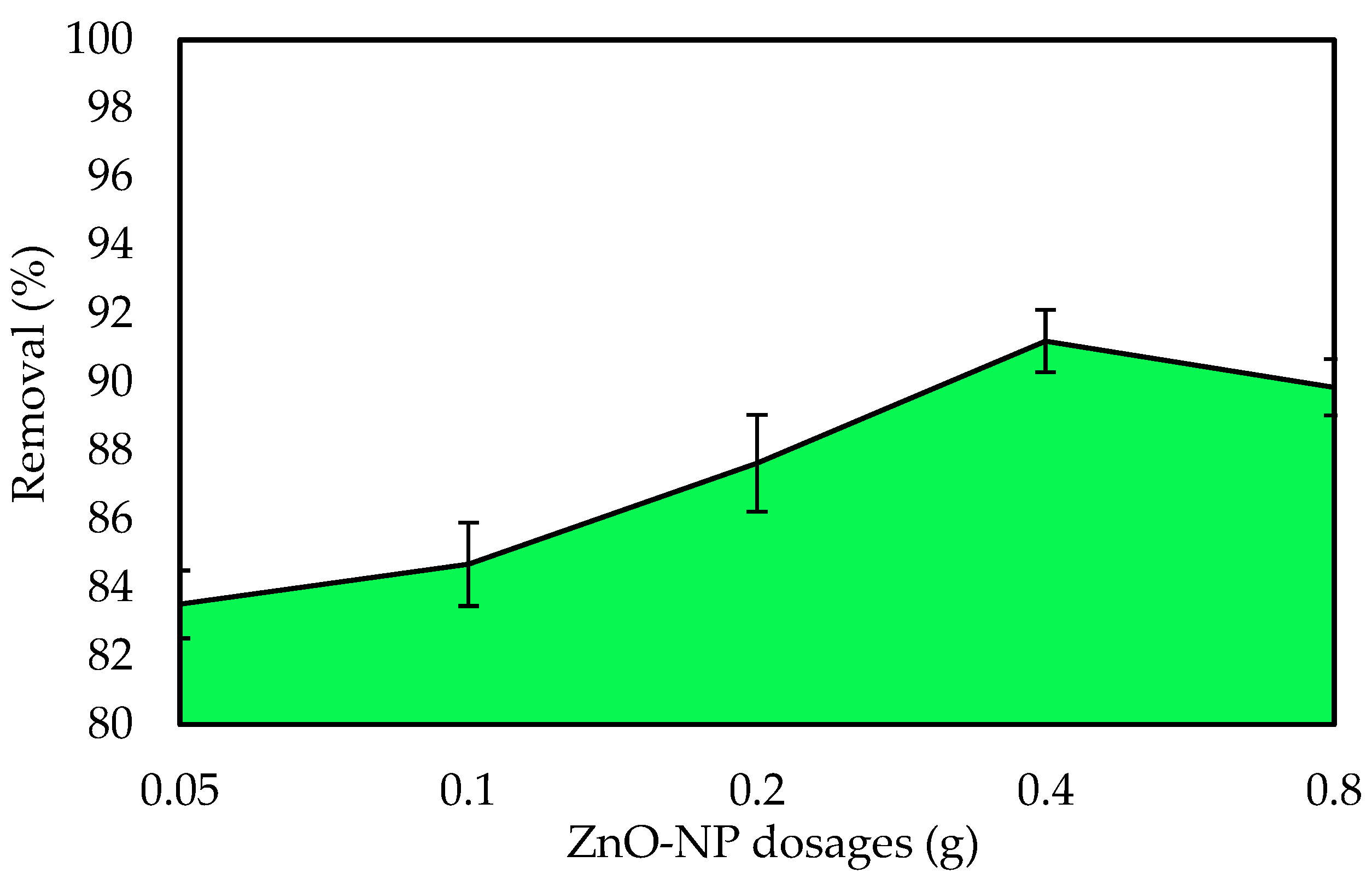
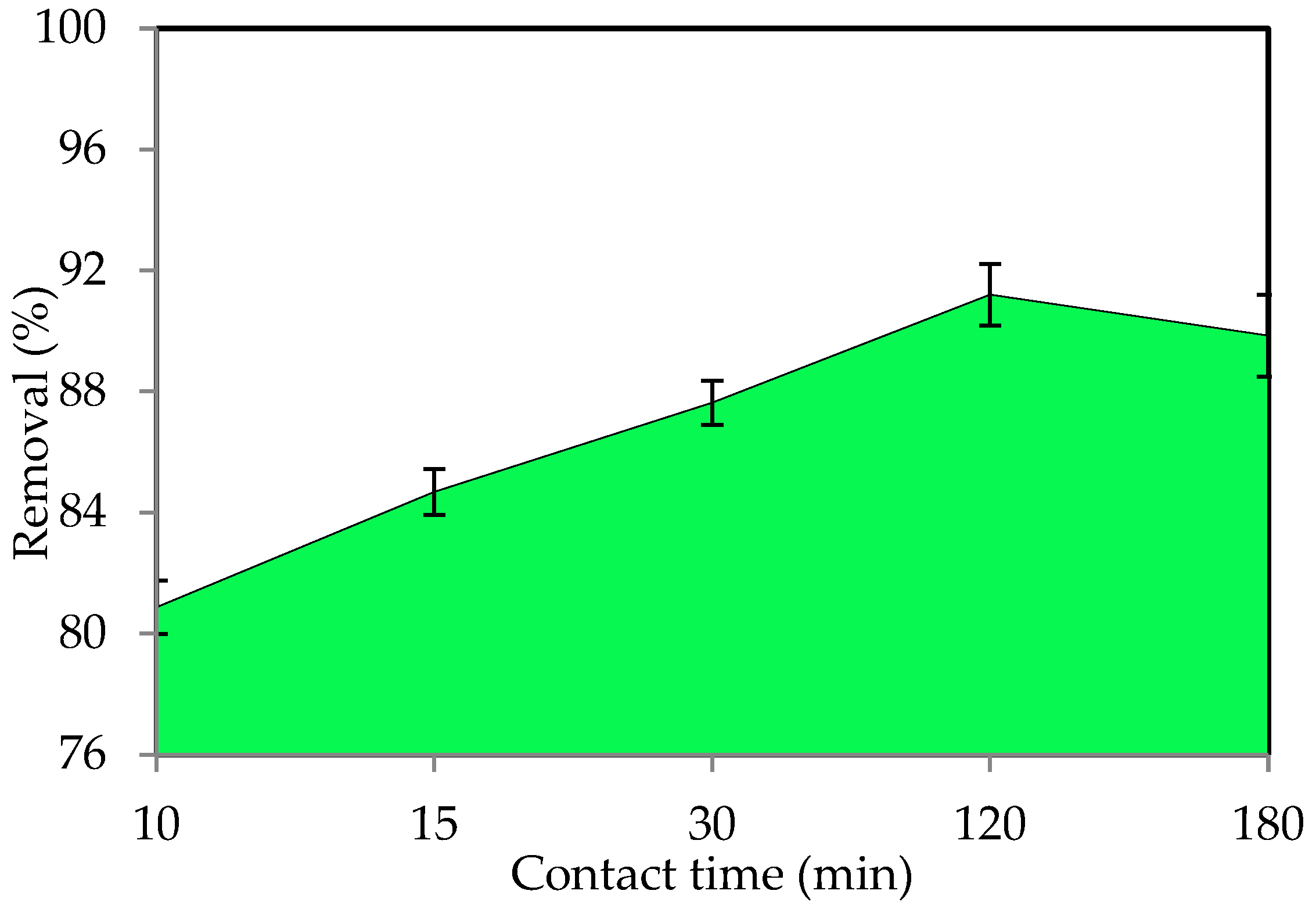
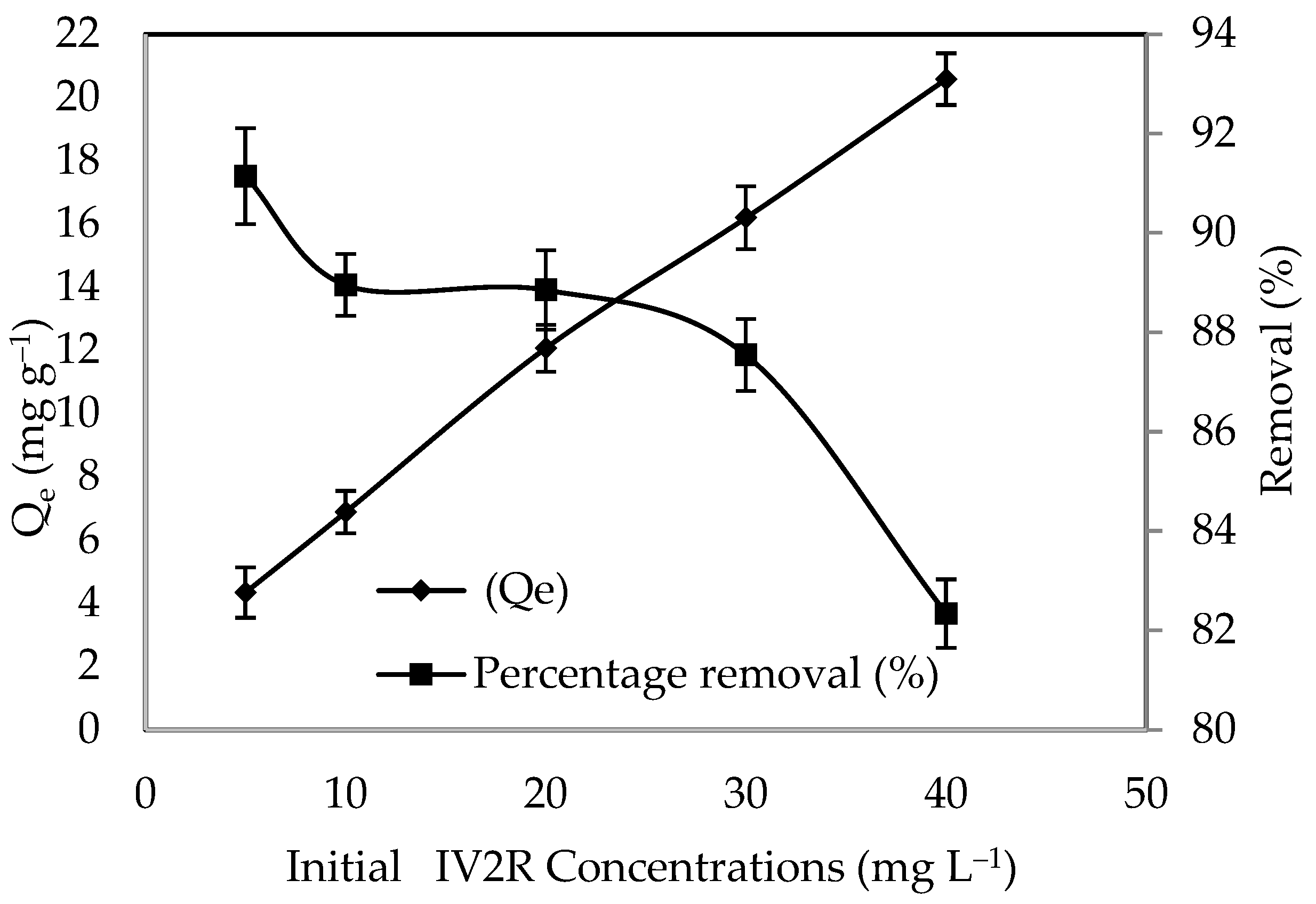
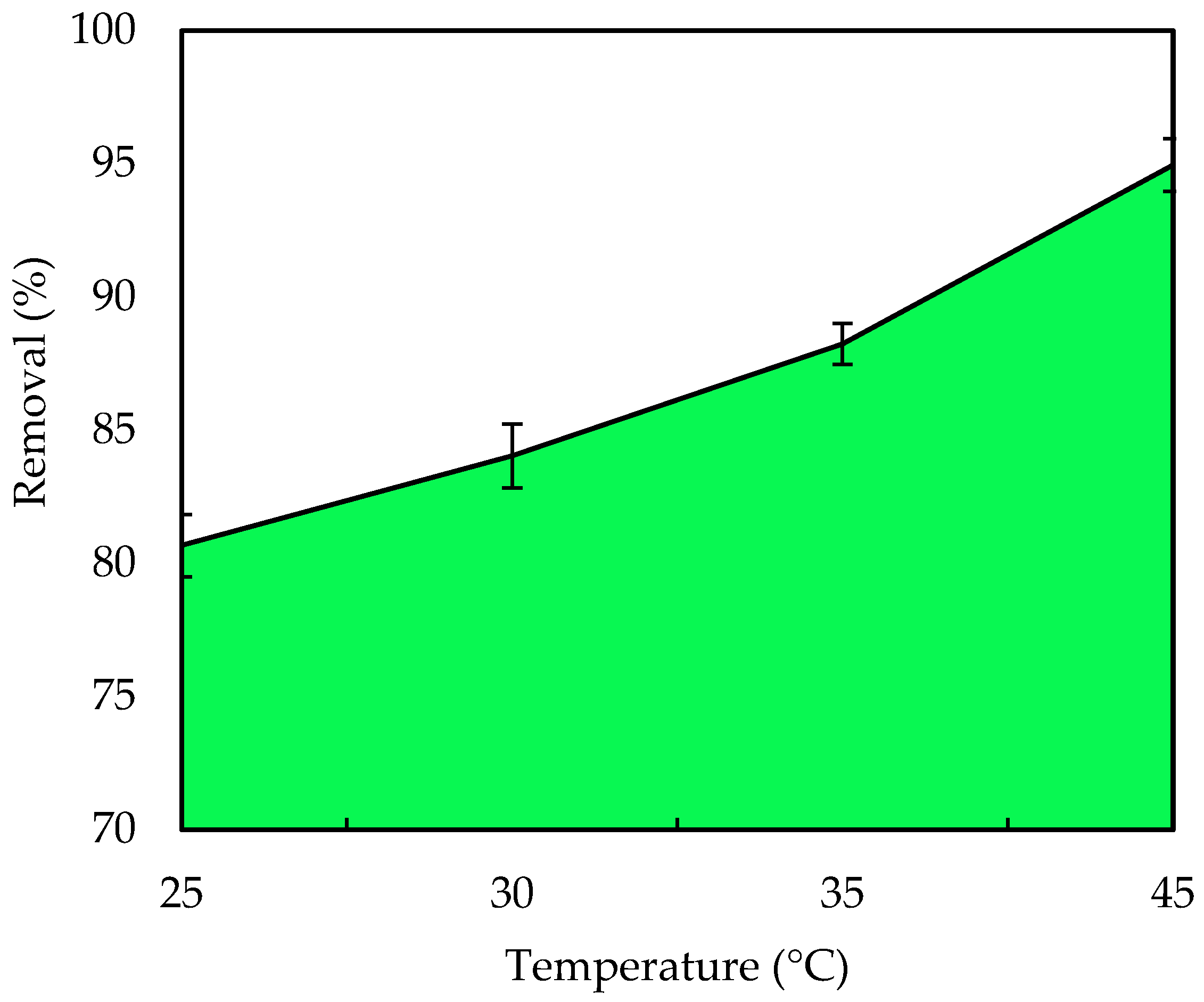
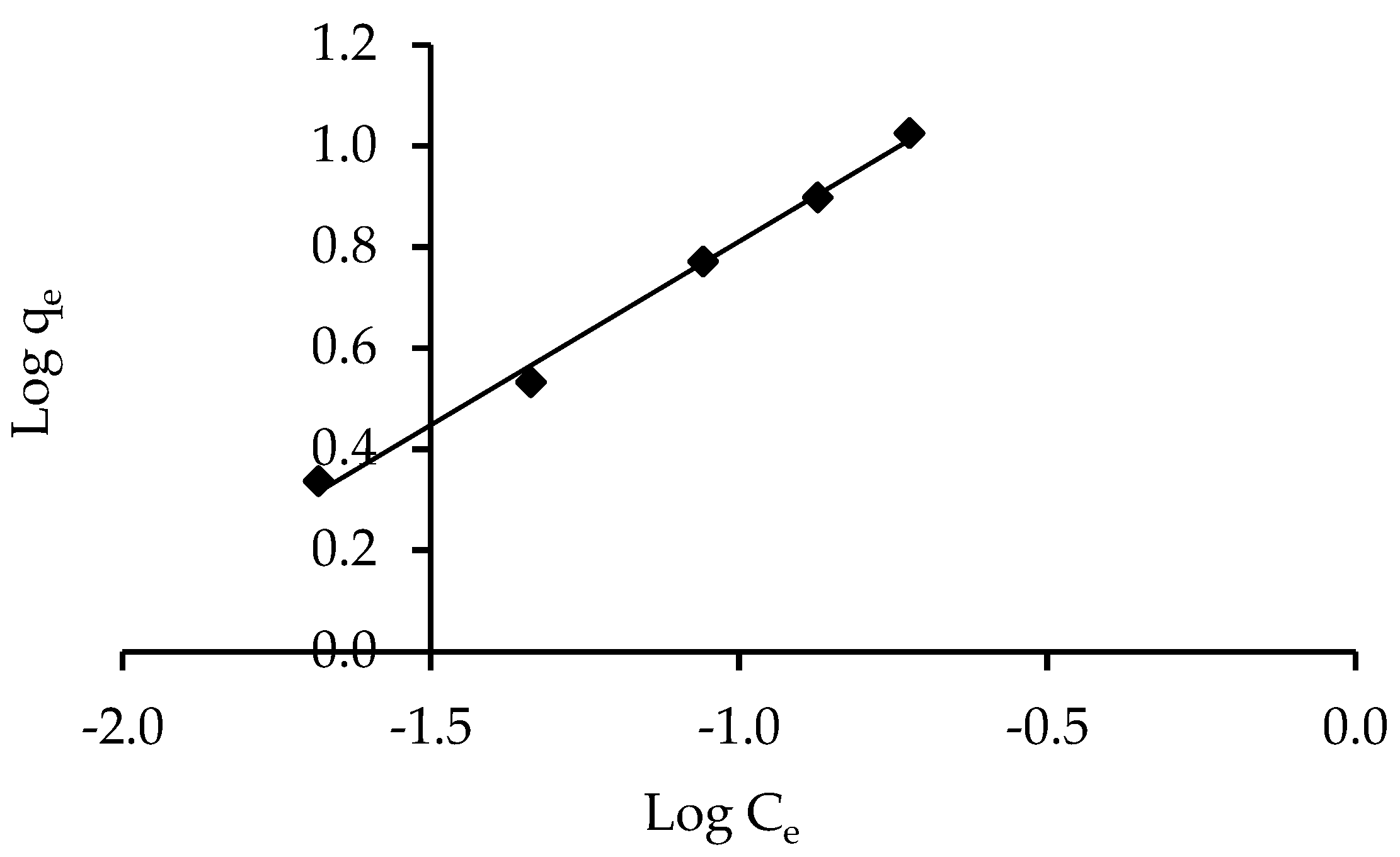
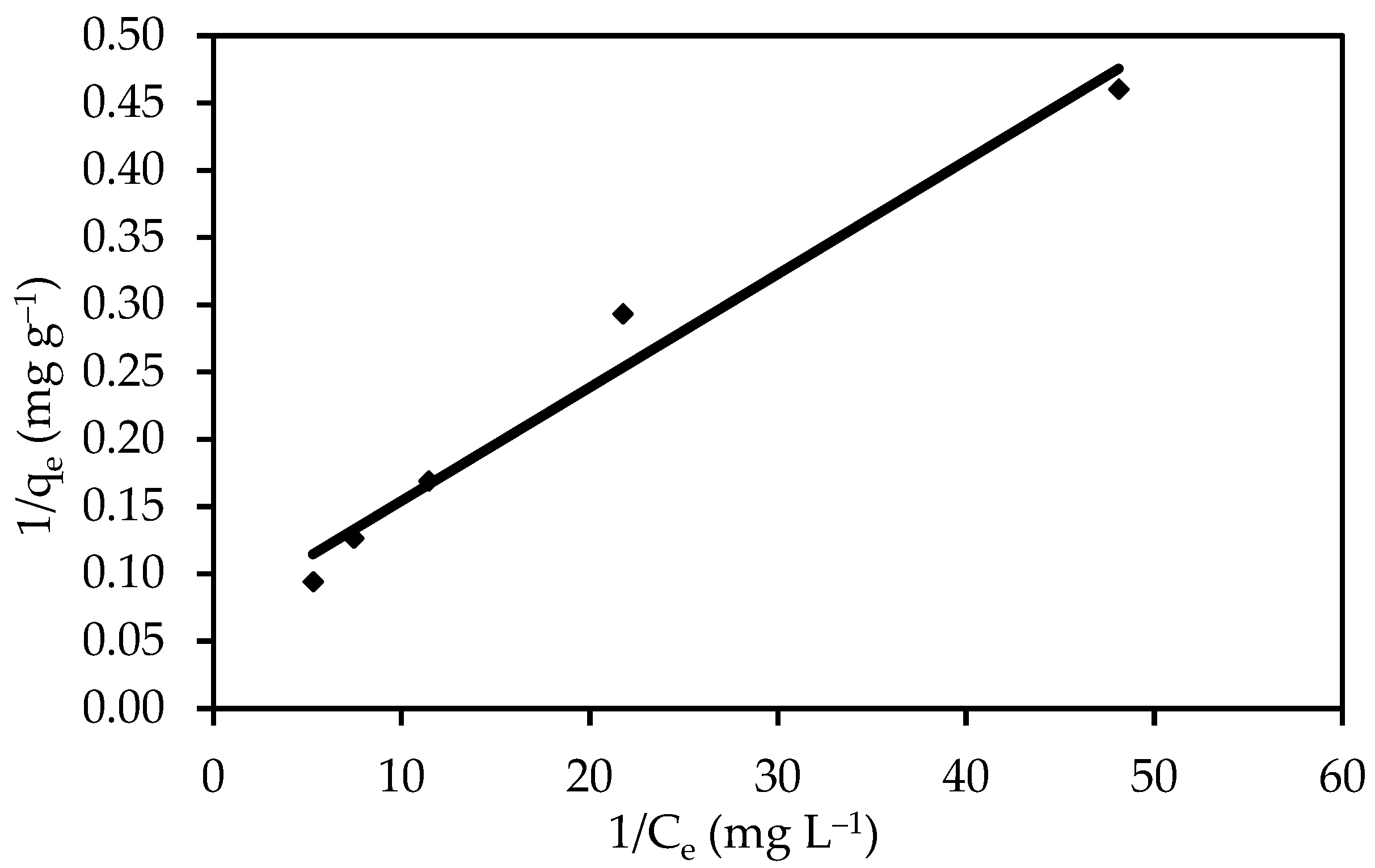

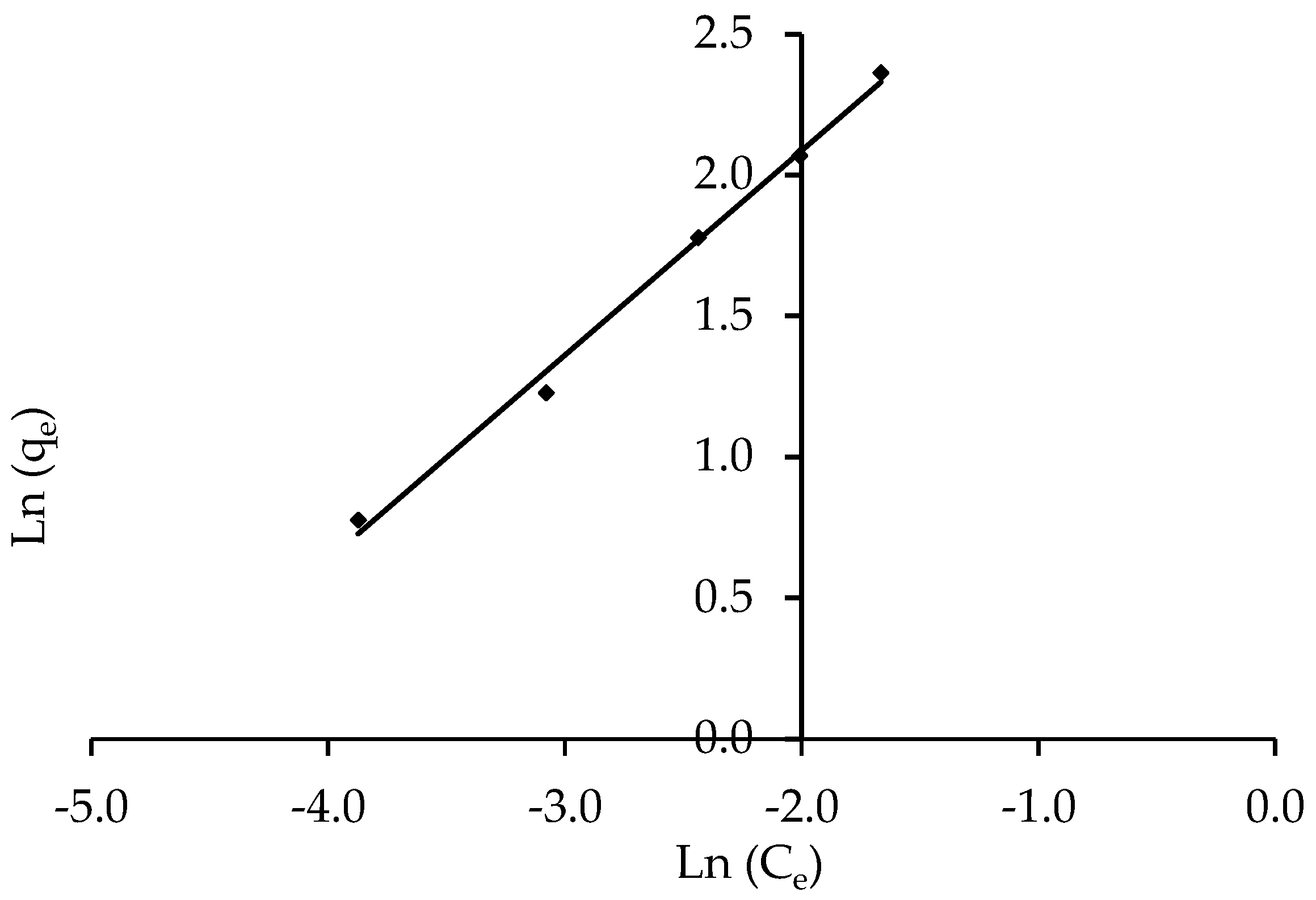

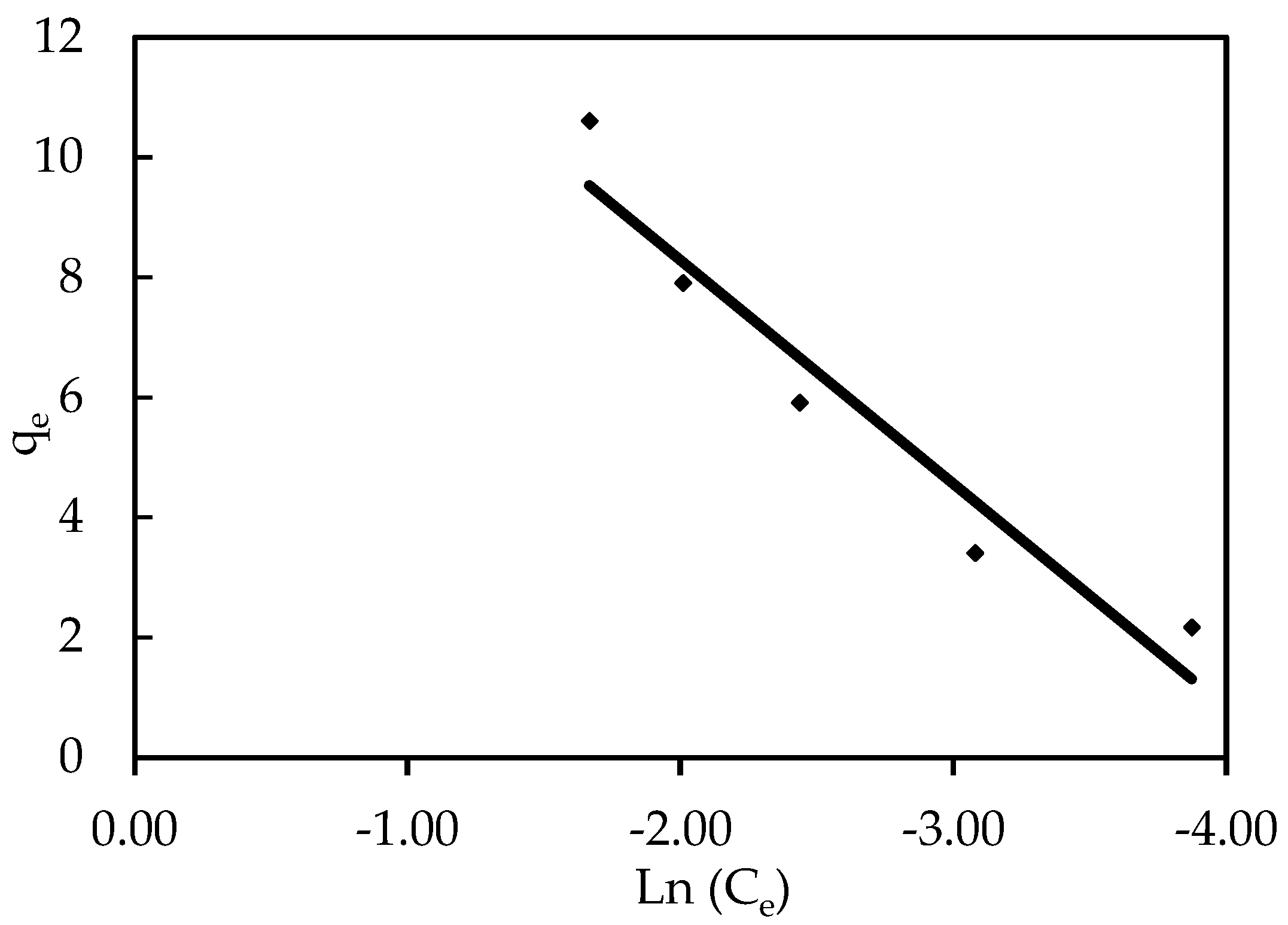
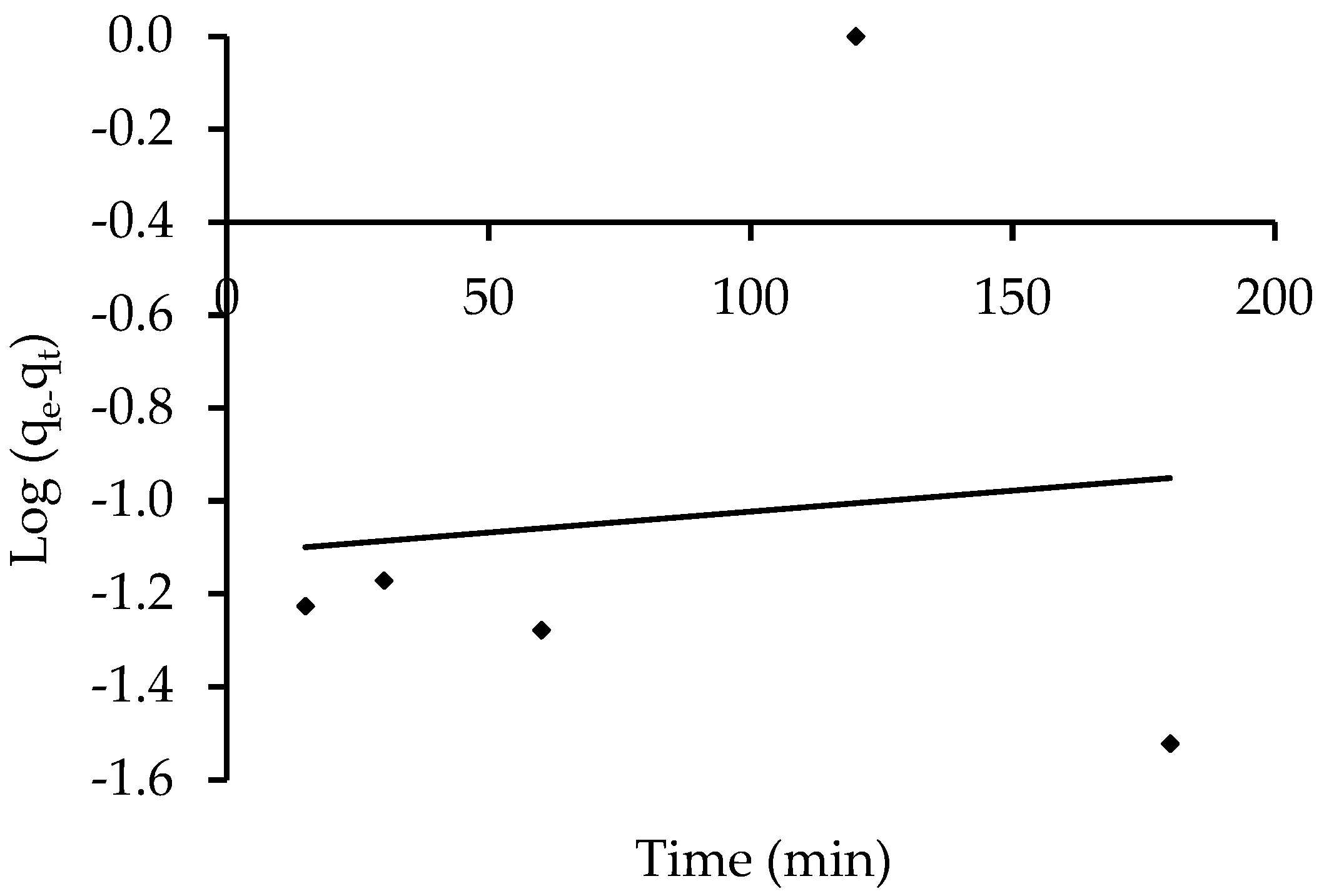
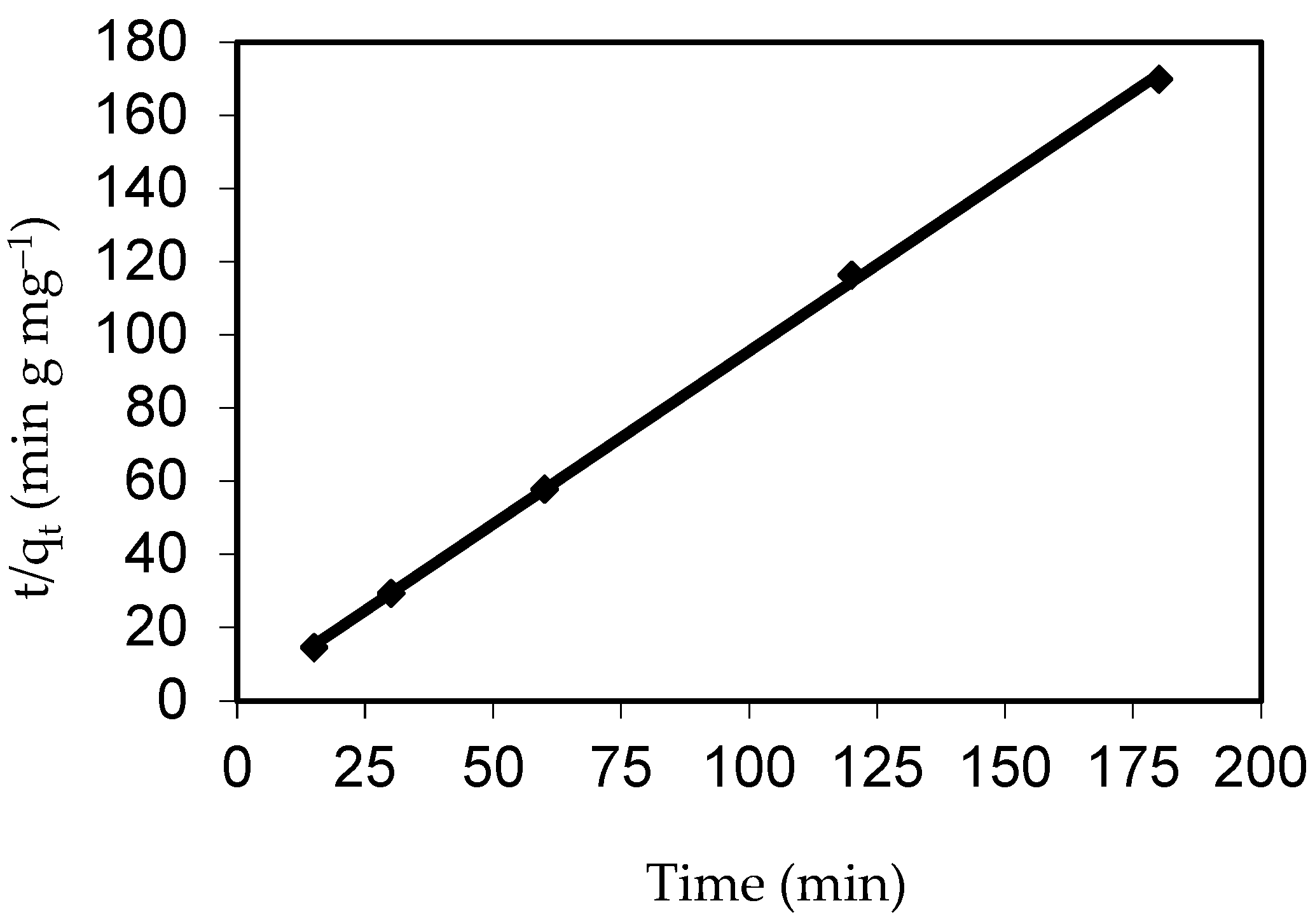

| Features | Data |
|---|---|
| Dye name | ISMATE violet 2R |
| Mol. wt. | 700 |
| Molecular formula | C22H14N4O11S3CuCl |
| Wavelength (λ max) | 550 nm |
| Molecular structure |  |
| Characteristics | Value/Unit |
|---|---|
| Density | 2.2 (g cm−3) |
| Langmuir method | 140.692 m² g−1 |
| BJH adsorption | 10.682 m² g−1 |
| BJH desorption | 8.847 m² g−1 |
| BET surface area | 95.838 m² g−1 |
| Average pore size | 1.228 nm |
| Total pore volume | 0.058 C2 g−1 |
| BJH adsorption cumulative micropore volume | 0.014 C2 g−1 |
| Average particle radius | 1.422 nm |
| Wavelength (nm) | Abs. |
|---|---|
| 390.50 | 0.100 |
| 243.000 | 0.528 |
| 380.51 | 0.350 |
| 500.86 | 0.537 |
| Isotherm Model | Isotherm Parameters | Value | EABS | X2 | APE (%) | Hybrid |
|---|---|---|---|---|---|---|
| Freundlich | 1/n | 0.725 | 1.87 | 0.116 | 0.1173 | 0.343 |
| n | 1.37 | |||||
| KF (mg1−1/n L1/n g−1) | 34.30 | |||||
| R2 | 0.994 | |||||
| Langmuir | Qmax (mg g−1) | 119.05 | 36.21 | 71.84 | 7.934 | 312.359 |
| b | 0.119 | |||||
| RL | 0.597 | |||||
| R2 | 0.974 | |||||
| Harkins-Jura | AHJ | 0.0047 | 762.50 | 754.6 | 3.95 | 3281.2 |
| BHJ | 0.80 | |||||
| R2 | 0.905 | |||||
| Halsey | n | 1.379 | 740.50 | 711.75 | 3.845 | 3094.5 |
| KH | 131 | |||||
| R2 | 0.994 | |||||
| Henderson | 1/nh | 1.426 | 0.178 | 0.000 | 0.024 | 0.005 |
| Kh | 0.007 | |||||
| R2 | 0.995 | |||||
| Tempkin | AT | 68.03 | 0.104 | 0.000 | 0.014 | 0.002 |
| BT | 3.72 | |||||
| bT | 255.5 | |||||
| R2 | 0.928 |
| Kinetic Models | Parameters | Value |
|---|---|---|
| First-order | qe (calc.) (mg g−1) | 12.94 |
| k1 × 103 (min−1) | 2.07 | |
| R2 | 0.011 | |
| Second-order | qe (calc.) (mg g−1) | 1.06 |
| k2 × 103 (mg g−1 min−1) | 818.54 | |
| R2 | 0.999 | |
| Intraparticle diffusion | Kdif (mg g−1 min−0.5) | 0.0028 |
| C cal (mg g−1) | 1.01 | |
| R2 | 0.596 |
| Temperature (°C) | ∆G° (kJ mol−1) | ∆H° (kJ mol−1) | ΔS° (kJ mol−1) |
|---|---|---|---|
| 25 | −12.98629244 | 47.92 | −0.202 |
| 30 | −12.8458117 | ||
| 35 | −12.81290783 | ||
| 45 | −20.94418521 | ||
| 55 | −16.5176115 |
| ZnO-NP. | Dye Adsorbed | qe (mg g−1) | Ref. |
|---|---|---|---|
| ZnO-NPs-AC | Acid yellow 119 | 116.29 | [80] |
| AC-ZnO | Acid orange 7 | 32.13 | [81] |
| AC-ZnO | Methylene blue (MB) | 32.22 | [81] |
| ZnO-NR-AC | Bromophenol red | 200 | [82] |
| ZnO-NP-AC | Malachite green | 322.58 | [83] |
| ZnO | Malachite green | 310.50 | [84] |
| ZnO-NRs-AC | 113.64 | [85] | |
| Chloroacetic Acid-Modified Ferula | Basic dye | 354.89 | [86] |
| ZnO-NP | IV2R | 119.05 | Present study |
Publisher’s Note: MDPI stays neutral with regard to jurisdictional claims in published maps and institutional affiliations. |
© 2022 by the author. Licensee MDPI, Basel, Switzerland. This article is an open access article distributed under the terms and conditions of the Creative Commons Attribution (CC BY) license (https://creativecommons.org/licenses/by/4.0/).
Share and Cite
Al-Arjan, W.S. Zinc Oxide Nanoparticles and Their Application in Adsorption of Toxic Dye from Aqueous Solution. Polymers 2022, 14, 3086. https://doi.org/10.3390/polym14153086
Al-Arjan WS. Zinc Oxide Nanoparticles and Their Application in Adsorption of Toxic Dye from Aqueous Solution. Polymers. 2022; 14(15):3086. https://doi.org/10.3390/polym14153086
Chicago/Turabian StyleAl-Arjan, Wafa Shamsan. 2022. "Zinc Oxide Nanoparticles and Their Application in Adsorption of Toxic Dye from Aqueous Solution" Polymers 14, no. 15: 3086. https://doi.org/10.3390/polym14153086
APA StyleAl-Arjan, W. S. (2022). Zinc Oxide Nanoparticles and Their Application in Adsorption of Toxic Dye from Aqueous Solution. Polymers, 14(15), 3086. https://doi.org/10.3390/polym14153086





